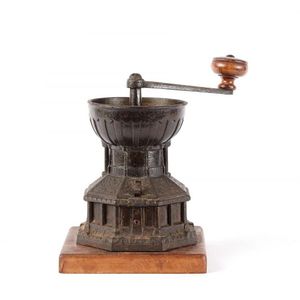Victorian Cast Iron Coffee Grinder
An old Victorian cast iron coffee grinder, circa 1850, the octagonal shaped body hinged in half an internal dish, long swing handle with rosewood knop, wooden base, Efficient working order, height 20 cm
You must be a subscriber, and be logged in to view price and dealer details.
Subscribe Now to view actual auction price for this item
When you subscribe, you have the option of setting the currency in which to display prices to $Au, $US, $NZ or Stg.
This item has been sold, and the description, image and price are for reference purposes only.
- Victorian Period - The Victorian period of furniture and decorative arts design covers the reign of Queen Victoria from 1837 to 1901. There was not one dominant style of furniture in the Victorian period. Designers used and modified many historical styles such as Gothic, Tudor, Elizabethan, English Rococo, Neoclassical and others, although use of some styles, such as English Rococo and Gothic tended to dominate the furniture manufacture of the period.
The Victorian period was preceded by the Regency and William IV periods, and followed by the Edwardian period, named for Edward VII (1841 ? 1910) who was King of the United Kingdom and the British Dominions and Emperor of India for the brief period from 1901 until his death in 1910. - Rosewood - A dense timber that varies in shade to very light brown to almost black. When rosewood is cut and sanded the colour of the timber will turn black, and after polishing and exposure to daylight, the surface will gradually lighten over time to light brown with black streaks.
The name comes from the odour emanating from the timber when it is planed, sanded or cut.
Rosewood was very popular for use in Victorian furniture in the second half of the 19th century, and at that time most of the rosewood was imported from Brazil. However it also grows in India and Indonesia.
It is used in the sold for chairs and table legs, but for carcase furniture such as side cabinets and bookcases, and for table tops it is always used as a veneer. - Circa - A Latin term meaning 'about', often used in the antique trade to give an approximate date for the piece, usually considered to be five years on either side of the circa year. Thus, circa 1900 means the piece was made about 1900, probably between 1895 and 1905. The expression is sometimes abbreviated to c.1900.
This item has been included into following indexes:
Visually similar items

Sewing tidy, New Zealand burr totara, circa 1860s. 22 cm
Sold by
in
for
You can display prices in $Au, $US, $NZ or Stg.

Leith Pottery (attributed), large and impressive neo-classical salt glazed garden urn, height 50 cm
Sold by
in
for
You can display prices in $Au, $US, $NZ or Stg.

Pokerwork kookaburra smokers stand with a match holder & a pipe holder. Height 88 cm
Sold by
in
for
You can display prices in $Au, $US, $NZ or Stg.

A Bankers oil lamp, English, brass with acid etched glass shade. 19th century. 55 cm high
Sold by
in
for
You can display prices in $Au, $US, $NZ or Stg.
